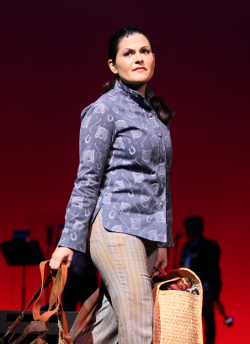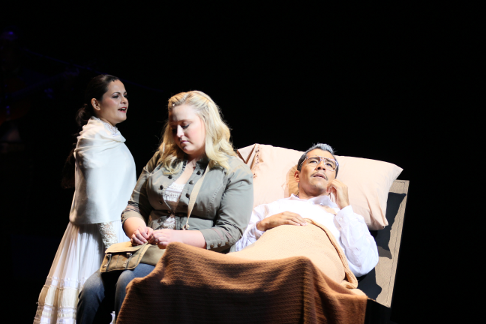![Brian Shircliffe as Mark [Photo by Edward Wilensky courtesy of San Diego Opera]](http://www.operatoday.com/IMG_3649.png)
26 Mar 2013
Cruzar la Cara de la Luna
Cruzar la Cara de la Luna (To Cross the Face of the Moon) has been performed in Houston and Paris.
English Touring Opera are delighted to announce a season of lyric monodramas to tour nationally from October to December. The season features music for solo singer and piano by Argento, Britten, Tippett and Shostakovich with a bold and inventive approach to making opera during social distancing.
This tenth of ten Live from London concerts was in fact a recorded live performance from California. It was no less enjoyable for that, and it was also uplifting to learn that this wasn’t in fact the ‘last’ LfL event that we will be able to enjoy, courtesy of VOCES8 and their fellow vocal ensembles (more below …).
Ever since Wigmore Hall announced their superb series of autumn concerts, all streamed live and available free of charge, I’d been looking forward to this song recital by Ian Bostridge and Imogen Cooper.
Although Stile Antico’s programme article for their Live from London recital introduced their selection from the many treasures of the English Renaissance in the context of the theological debates and upheavals of the Tudor and Elizabethan years, their performance was more evocative of private chamber music than of public liturgy.
Evidently, face masks don’t stifle appreciative “Bravo!”s. And, reducing audience numbers doesn’t lower the volume of such acclamations. For, the audience at Wigmore Hall gave soprano Elizabeth Llewellyn and pianist Simon Lepper a greatly deserved warm reception and hearty response following this lunchtime recital of late-Romantic song.
For this week’s Live from London vocal recital we moved from the home of VOCES8, St Anne and St Agnes in the City of London, to Kings Place, where The Sixteen - who have been associate artists at the venue for some time - presented a programme of music and words bound together by the theme of ‘reflection’.
'Such is your divine Disposation that both you excellently understand, and royally entertaine the Exercise of Musicke.’
‘And there was war in heaven: Michael and his angels fought against the dragon; and the dragon fought and his angels, And prevailed not; neither was their place found any more in heaven … that old serpent … Satan, which deceiveth the whole world: he was cast out into the earth, and his angels were cast out with him.’
There was never any doubt that the fifth of the twelve Met Stars Live in Concert broadcasts was going to be a palpably intense and vivid event, as well as a musically stunning and theatrically enervating experience.
‘Love’ was the theme for this Live from London performance by Apollo5. Given the complexity and diversity of that human emotion, and Apollo5’s reputation for versatility and diverse repertoire, ranging from Renaissance choral music to jazz, from contemporary classical works to popular song, it was no surprise that their programme spanned 500 years and several musical styles.
The Academy of St Martin in the Fields have titled their autumn series of eight concerts - which are taking place at 5pm and 7.30pm on two Saturdays each month at their home venue in Trafalgar Square, and being filmed for streaming the following Thursday - ‘re:connect’.
The London Symphony Orchestra opened their Autumn 2020 season with a homage to Oliver Knussen, who died at the age of 66 in July 2018. The programme traced a national musical lineage through the twentieth century, from Britten to Knussen, on to Mark-Anthony Turnage, and entwining the LSO and Rattle too.
With the Live from London digital vocal festival entering the second half of the series, the festival’s host, VOCES8, returned to their home at St Annes and St Agnes in the City of London to present a sequence of ‘Choral Dances’ - vocal music inspired by dance, embracing diverse genres from the Renaissance madrigal to swing jazz.
Just a few unison string wriggles from the opening of Mozart’s overture to Le nozze di Figaro are enough to make any opera-lover perch on the edge of their seat, in excited anticipation of the drama in music to come, so there could be no other curtain-raiser for this Gala Concert at the Royal Opera House, the latest instalment from ‘their House’ to ‘our houses’.
"Before the ending of the day, creator of all things, we pray that, with your accustomed mercy, you may watch over us."
The doors at The Metropolitan Opera will not open to live audiences until 2021 at the earliest, and the likelihood of normal operatic life resuming in cities around the world looks but a distant dream at present. But, while we may not be invited from our homes into the opera house for some time yet, with its free daily screenings of past productions and its pay-per-view Met Stars Live in Concert series, the Met continues to bring opera into our homes.
Music-making at this year’s Grange Festival Opera may have fallen silent in June and July, but the country house and extensive grounds of The Grange provided an ideal setting for a weekend of twelve specially conceived ‘promenade’ performances encompassing music and dance.
There’s a “slide of harmony” and “all the bones leave your body at that moment and you collapse to the floor, it’s so extraordinary.”
“Music for a while, shall all your cares beguile.”
The hum of bees rising from myriad scented blooms; gentle strains of birdsong; the cheerful chatter of picnickers beside a still lake; decorous thwacks of leather on willow; song and music floating through the warm evening air.
![Brian Shircliffe as Mark [Photo by Edward Wilensky courtesy of San Diego Opera]](http://www.operatoday.com/IMG_3649.png)
Cruzar la Cara de la Luna (To Cross the Face of the Moon) has been performed in Houston and Paris.
The matinee performance on Saturday March 16, 2013, in San Diego was the work's West Coast premiere. The title refers to the yearly migration of monarch butterflies between the United States and Mexico.
Prior to the arrival of the Spanish, the indigenous people of Mexico made music with rattles, drums, flutes, and conch-shell horns. The Spanish introduced violins, guitars, harps, brass instruments, and woodwinds which tended to replaced most of the original instruments. Native peoples learned to play and eventually to make the European instruments, which were first used only for Mass. Later the new instruments came into more general use but some of their shapes and tunings were adjusted for local use. Mexican music has evolved greatly over the intervening centuries, so it has undergone many changes. Mariachi music is thought to have developed from "Son" music, which featured guitars and harps played by part time musicians wearing huarache sandals and white clothing.
 Cecilia Duarte as Renata
Cecilia Duarte as Renata
By the end of the nineteenth century, the traditions of European music were firmly established in Mexico and various forms of musical entertainment were written and performed by both Mexican and European artists. In rural areas, the members of local bands wore in charro outfits. Later this clothing would be worn by urban Mariachi bands, which until recently were all male. Mariachi music and the musicians who played it became more professional in the nineteen forties and fifties. Mariachi Vargas became a legend, appearing in films and accompanying stars singers. The group expanded by the addition of trumpets, violins and even a classical guitar so that they became a kind of orchestra, keeping the traditional son/mariachi base while integrating new musical ideas and styles. Mariachi Vargas traces its history from the 1890s. Generations of players have maintained the group's authenticity as a mariachi band while the music has evolved. Although the last Vargas associated with the group died in 1985, the group still considers itself the original band because the music has been passed down from one generation of musicians to the next.
Cruzar la Cara de la Luna (To Cross the Face of the Moon) has been performed in Houston and Paris. The matinee performance on Saturday March 16, 2013, in San Diego was the work's West Coast premiere. The title refers to the yearly migration of monarch butterflies between the United States and Mexico. Members of families, too, migrate between the two countries and sometimes spend a great deal of time away from their loved ones. Much of the audience in San Diego's sold out Civic Theater was Mexican-American and many of the people could relate personally to the family portrayed on stage. The show opened with Brian Shircliffe as Mark singing of the butterflies and accompanying himself on the guitar. His baritone voice sounded like liquid gold and his song was the beginning of a very intense performance.
Soprano Brittany Wheeler portrayed the Americanized Diana, a member of the latter generation, who wanted to catch up with her Mexican past. Vanessa Cerda-Alonzo was Lupita, a Mexican village wife whose husband was spending most of his time away from her. Both of them sang with dramatic tones as they portrayed their important characters. Colombian tenor David Guzman was the lone high male voice in this performance and his trumpet-like sound was a good fit with the Mariachi orchestra and the lower voices of much of the cast.
 Cecilia Duarte as Renata, Brittany Wheeler as Diana and Octavio Moreno as Laurentino
Cecilia Duarte as Renata, Brittany Wheeler as Diana and Octavio Moreno as Laurentino
The most fascinating character was Renata, played by Mexican mezzo-soprano Cecilia Duarte. She sang both lyrical and dramatic songs, she also danced, and her characterization brought tears to the eyes of many in the audience. Because Renata missed her husband, she hired a guide to take her and her son to him. She told no one that she was pregnant and wanted her baby to be born in the States. Unfortunately the long walk through the desert was too hard for her and, like others before her, she died before reaching her goal. The guide took the little boy back to Mexico, but he did not see his father for many years. Duarte gave an amazing performance and I would love to see her again.
Saul Avalos was a committed Chucho; Octavio Moreno a strong voiced Laurentino, and Juan Mejia an energetic Victor. The music composed by José Pepe Martinez is sometimes dramatic and at other times lyrical with kind of a big band sound from muted trumpets. His use of the harp added welcome rhythmic textures while the text told the story clearly and with considerable detail. Foglia's scenery was practical, Cesar Galindo's costumes attractive, and the lighting by Brian Nason made the visuals most effective.
Supertitles were offered in both languages so that whether you spoke Spanish or English you always knew what was being sung. The Mariachi band was led by violinist Jose Martinez, Sr. The three trumpets were always perfectly in tune, as were the harp, vihuela, guitarron, and guitar, but there were one or two instances when the violins were not completely synchronized. It's a shame that the company was only in San Diego for one day. Let's hope they will soon be back. Before and after the opera there were performances by Mariachi bands on the plaza outside the theater and it was good to see so many excellent local groups taking part.
Maria Nockin